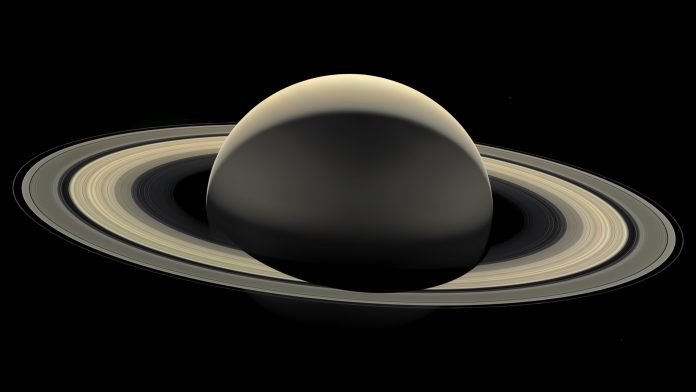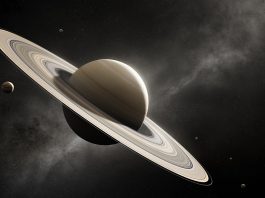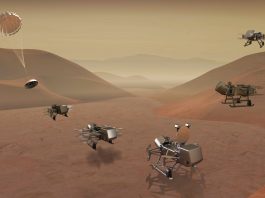Dr Larry Esposito from the Laboratory for Atmospheric and Space Physics at the University of Colorado, Boulder discusses Saturn’s rings – from Cassini discoveries to future exploration
One of the most enduring symbols of space exploration is a planet surrounded by a ring. This symbol inspires a celestial context: nothing on Earth is like it. Earth once possessed a ring of debris that coalesced to form our own Moon. It is likely that planets around other stars also have rings. I have had the good fortune to be an investigator on the space missions Pioneer Saturn, Voyager, and Cassini that each visited the planet Saturn and studied its ring system and associated moons. It has been a wonderful surprise that Saturn’s rings are just as beautiful and scientifically compelling seen close up. Furthermore, Saturn’s ring system is not just an object of beauty, but a complicated physical system that provides a local laboratory and analogy for other flat cosmic systems like spiral galaxies and planet-forming disks.
It is now known that planetary rings, once thought unique to the planet Saturn, exist around all the giant planets. These rings are not solid objects but are composed of countless particles with sizes ranging from specks of dust to small moons. For each planet, the rings are quite different. Jupiter’s ring is thin and composed of small, dust-like particles. Saturn’s rings are broad, bright, and opaque. Uranus has narrow, dark rings among broad lanes of dust that are invisible from Earth. Neptune’s rings include incomplete arcs restricted to a small range of their circumference. All rings lie predominantly within their planet’s Roche limit, where tidal forces would destroy a self-gravitating fluid body.
The common occurrence of ring material around the planets is one of the major scientific findings of the last 40 years. The new ring systems were discovered by both spacecraft and ground-based observers, often surprising by contradicting our expectations. The rings’ appearance and composition differ among the various planets, and likewise within each ring system. Most of the ringed planets have dim and relatively small ring systems. The brightest and broadest set of rings with the most active processes is found around the planet Saturn, which was scrutinised by the U.S./European Cassini space mission from 2004 to 2017 (see Fig. 1).
The particles in Saturn’s rings come in a broad range of sizes. Their size distribution extends from submicron dust to meter-sized particles to small embedded moons 100–1,000m in radius. The largest may be like Saturn’s moons Pan and Daphnis, about 10km in radius.
What are the ring particles made of? Measurements all imply that the particles of Saturn’s rings are almost entirely water ice. They are bright, like the surfaces of Saturn’s inner satellites. Their colour and spectral variations indicate compositional differences between different parts of the rings. Some of these differences may be primordial; others arrive from interactions with the environment, including meteoroid bombardment.
We astronomers have a first-order understanding of the dynamics and key processes in Saturn’s rings, much of it based on previous work in galactic and stellar dynamics. Unfortunately, the models are often idealised and cannot yet predict many phenomena in the detail observed by spacecraft. The latest Cassini data show spectacularly that the rings do not behave like a simple fluid. Many puzzles of the ring dynamics are still unsolved after three decades of study!
Saturn’s rings show many youthful features: these icy rings are bright and appear relatively undarkened by continually infalling meteoritic dust. In addition, the small moons discovered by Voyager could not themselves have survived the flux of interplanetary meteoroids for the age of the Solar System. In much less time, these small moons would be shattered by an impacting object.
This realisation provides a potential solution to the problem of young rings. These impacts not only destroy the moons, but they can also recreate the ring systems. The new rings would gradually spread and eventually be ground to dust. Shattered moons can re-form to provide material for future rings. Moons can naturally form as the rings spread away from Saturn. Data from Cassini’s observations indicate the moons not only sculpt the rings’ structure; they also provide the reservoirs for past and future ring systems and possibly trigger new structures forming now. Thus, the rings may provide the material creating past and future moons.
This unexpected range of phenomena seen in Saturn’s rings gives some insight into the processes in other flattened astrophysical systems. The processes now observed in planetary ring systems parallel those that occurred at the time of the origin of the planets. Clearly, Saturn’s rings are not now accreting to form planets, as the original planetesimals did in the birth of our Solar System. However, many processes are occurring now in rings that resemble those that occurred in the original solar nebula, particularly interactions between the disk and embedded protoplanets. Models that explain the present processes in rings can be compared in detail to Saturn ring observations, allowing testing and refinement that is no longer possible for the early Solar System.
In 2009, the Cassini space mission observed the Sun setting on the rings, which occurs every 15 years, at the time of Saturn’s equinox. This unique viewing perspective allowed structures never before viewed to be seen briefly (see Fig. 2).
Cassini continued to observe Saturn’s rings until the mission’s end in 2017. Fortunately for Cassini, the spacecraft never crashed into the rings. Even small particles of 1mm or so can be deadly, but they are likely to be rare outside the visible rings. Unfortunately, this avoidance means that no close-up views of individual ring particles were attained. NASA has considered plans for a future ‘Saturn Ring Observer’ mission that would come close enough to Saturn’s rings to hover and capture pictures of the individual particles. Such views would provide spectacular ‘ground truth’ for the remote sensing from flyby and orbiter spacecraft.
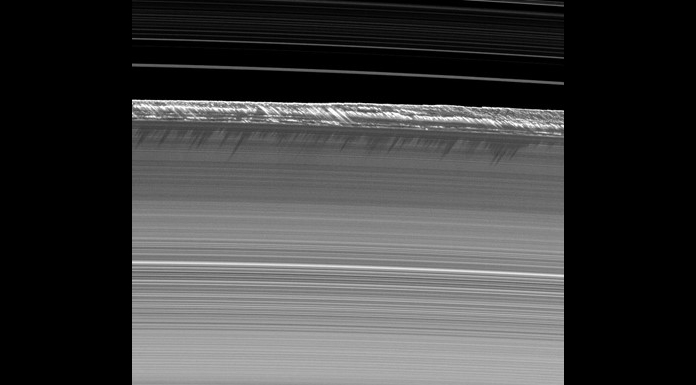
History of ring studies
The possibility of rings surrounding the planets was not imagined by the ancients. Even the possibility that the planets possess moons was a surprise to Renaissance intellectuals. This latter finding was one of the first discoveries made by Galileo with the newly invented telescope in 1609, when he turned his view to Jupiter and discovered it to be accompanied by the four small objects: Io, Europa, Ganymede, and Callisto. In 1610, Galileo turned his telescope to Saturn. With his imperfect optics, it seemed that the planet had a giant moon to either side. But these ‘moons’ were unlike the Jupiter satellites he had found previously: they apparently remained stationary. In 1656, the Dutch astronomer Christiaan Huygens deduced the correct explanation and published it as a Latin anagram. The flattened rings appear differently at each Saturn season, as viewed from the Earth; in fact, they vanish when the Earth passes through the plane of Saturn’s equator. Cassini’s close-up observations during the equinox of 2009 confirm that the rings are flat and thin, but with occasional excursions up to a few kilometres in some gravitationally perturbed regions, as for example in Fig. 2.
Huygens argued that his telescope was superior to those with whom he disputed, but this was not justified. In fact, his contemporaries had observed the same phenomena as he had but had not interpreted them as he did. The difference was not in seeing the rings, but in perceiving them.
It is clear that Huygens was drawn to the correct solution as much (or more) by his philosophical conceptions as by his own observations. In the more recent history of planetary ring studies, a similar situation is evident: repeatedly it has been found that we must overcome our common preconceptions in order to understand the rings. Particularly, there is a need to reverse the model of Saturn’s rings that persisted up until the late 1970s as simple, circular, unchanging, equal-sized bodies orbiting the planet. Spacecraft and ground-based observations have forced astronomers to drop the simple models and embrace a much more complicated and active view of planetary rings. The rings themselves have changed between the Voyager and Cassini missions. The Cassini observations continue to provide a sharp incentive, challenging astronomers to extend their thinking and drop their preconceptions to truly understand the nature and history of planetary rings.
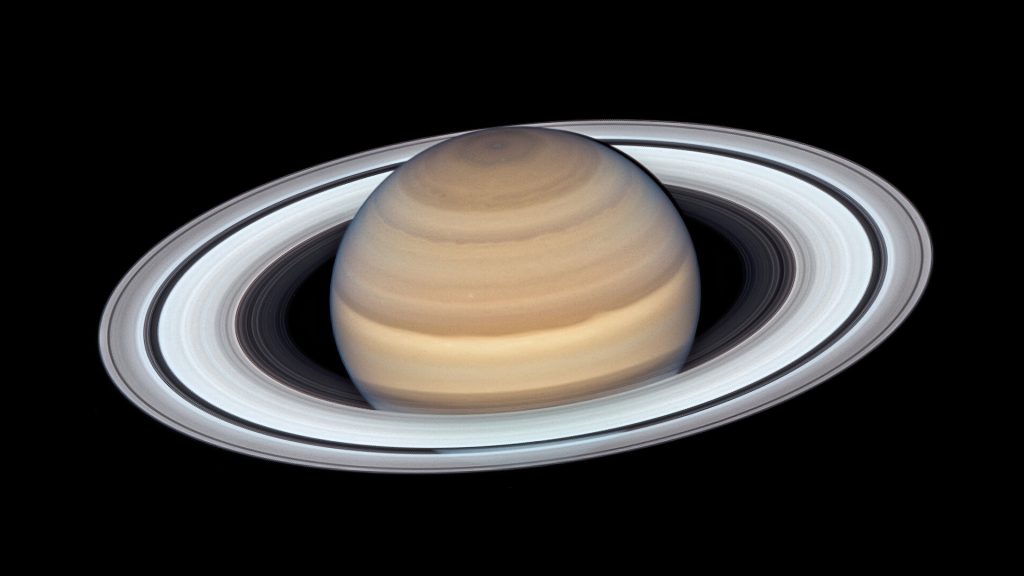
The NASA/ESA Hubble Space Telescope’s Wide Field Camera 3 observed Saturn on 20 June 2019 as the planet made its closest approach to Earth this year, at approximately 1.36 billion kilometres away
Spacecraft studies of Saturn’s rings
In the 1970s, the first spacecraft were on their way to Saturn: Pioneer 11 had flown by Jupiter in 1974 and would reach it in 1979; Voyager 1 and Voyager 2 would fly by Saturn in 1979 and 1981 after gravity assists from Jupiter in 1979. Two new moons, now known as Pandora and Prometheus, were found on either side of Saturn’s F ring, apparently confirming the ‘shepherding’ theory, that the ring is held in place by gravitational forces from these small moons.
One of the most remarkable discoveries of the Voyager encounters was the numerous waves visible in Saturn’s rings. Each wave was generated at a location in the rings where the natural orbital motions of the particles was in a resonance with the motion of a nearby moon. Remarkably, these spiral waves could be explained by the same theory developed earlier to explain the arms of spiral galaxies. These waves now provide estimates of the rings’ total mass, particle velocities, thickness, and age.
Cassini observations confirm that the ring particles are composed of mostly pure water ice, with some contaminants. The particles cover a range of sizes, from dust to small moons. Some small embedded moons were discovered by noticing a propeller-shaped effect on nearby ring material. Cassini showed that the ring particles form temporary elongated aggregates tens of meters across, called ‘self-gravity wakes’. A few aspects of ring structure can even change in a matter of days or weeks: the rings can literally be seen to change before our eyes! The rapid evolution is hard to reconcile with ancient rings as old as the Solar System, unless some renewal or recycling is occurring. Cassini directly measured Saturn’s rings’ mass and the nature of the interplanetary particles that continually bombard it. These results combine to show that the apparent age of the ring system is much younger than the planet itself, perhaps recently created from the destruction of a former moon.
At the end of the Cassini mission, before it became a short-lived meteor in Saturn’s atmosphere, many close-up views were possible; during the last orbits, Cassini sped between the rings and Saturn around the time of its closest approach. The spacecraft passed so close to the rings that their gravity changed its orbit slightly, allowing us to directly measure, for the first time, the mass of the rings. This key result tested theories of the rings’ age and evolution, showing a mass similar to the Voyager estimates, and consistent with the rings being younger than Saturn.
Ring researchers are now in a position to understand the collisional dynamics, origin of structure, and long-term history of rings. They form by fragmentation of a moon; rapidly flatten into an equatorial disk; and spread slowly, sculpted by gravity from nearby moons. The ring particles are likely dynamic, ephemeral bodies like piles of rubble, which repeatedly aggregate and come apart. Collisions and meteoroid bombardment release dust, which is subject to more physical processes and thus is rapidly swept away.
Nonetheless, many details of origin and interaction, formation of radial and azimuthal structure, and individual particle characteristics are unknown. Discoveries in these areas could lead to major new understanding and concepts about planetary rings.
The origin of Saturn’s rings
Saturn’s rings are subjected to a variety of processes that sculpt their structure and modify their composition on rapid time scales, much shorter than the age of the Solar System. Although this suggests the rings are much younger than the solar System, the possibility that rings have formed during the last billion years is highly improbable. The large mass of Saturn’s rings (much greater than the other giant planet ring systems) and their bright icy composition makes an explanation of their origin problematic. Three different scenarios are probably the more likely for the formation of Saturn’s main rings
- They may be the remnants from a destroyed satellite;
2. They may result from a tidally split comet; and
3. They may be the outcome of the tidal disruption of a differentiated, Titan-sized satellite.
We must conclude that the origin of Saturn’s rings is still an open question. Each proposed scenario faces its own problems. Forming rings in the last 3 billion years is a difficult task, because there is no known restructuring event in this period.
Perhaps the most popular now is the third scenario. A recent model explains the rings as the result of a tidal disruption of a differentiated, Titan-sized satellite as it moves inward toward the planet. A large differentiated satellite that drifts within the classical Roche limit of the planet would probably have an ‘ice mantle’ and a rocky (and perhaps metallic) core; planetary tides would likely strip material from the less dense ice mantle, whereas the core eventually collides with the planet. The ring material that spreads beyond the Roche limit (due to interparticle collisions) accretes into icy moons; these moons are then driven away from the ring by resonant torques and continue to evolve outward as a consequence of planetary tides while new moons are generated from the ring’s outer edge.
This scenario for the origin of Saturn’s ring system was probably the most likely before the final Cassini plunge. Indeed it implies an initial ring that is several orders of magnitude more massive than the current rings; such a massive early ring would be less subjected to pollution by micrometeoroid impacts, and it could provide the necessary mass and angular momentum to account for the whole ring system. In addition, this model provides a likely explanation for the icy composition of Saturn’s rings and the ice-rich composition of the Saturnian satellites.
Conversely, observations from Cassini’s grand finale support the idea that Saturn’s rings are much younger than the Solar System. During Cassini’s final 22 orbits, it flew between the rings and the cloud tops. This yielded a mass of the rings of 40% of the mass of Saturn’s small moon Mimas. Comparing this to the polluting mass influx measured by Cassini, this gives an age estimate of 10 million – 100 million years. This young age estimate emphasises our unsolved problem: to explain how the rings formed so recently. All the plausible events creating the rings are much more likely early in Solar System history, and quite improbable now. Because the rings now appear to be nearly pure ice, this might require them also to be much more massive, or that the bombarding mass flux has been overestimated by tenfold. This would explain why they are not more polluted by the continuing infall of meteoritic material on the rings.
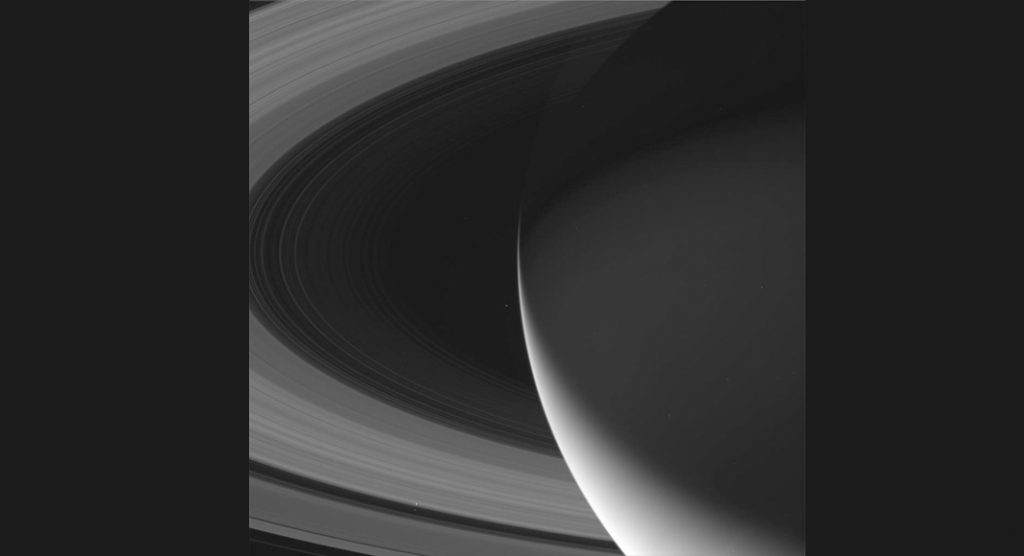
This raw, unprocessed image of Saturn was taken by Cassini on 12 August 2017 and received on Earth 13 August 2017. The camera was pointing toward Saturn at approximately 938,955 kilometres away, and the image was taken using the CL1 and RED filters. The image has not been validated or calibrated
Future Ring Studies
Saturn’s rings show clear parallels with astrophysical disks. Future studies of the wealth from Cassini and future ground-based observations (along with Hubble Space Telescope) will likely combine with improving numerical simulations to better understand both these types of systems.
A future Saturn Ring Observer would be in a ‘hovering’ circular non-Kelerian orbit just outside the outer edge on Saturn’s A ring, remaining 2-3km above the ring plane. This could provide close-up observations of individual particles and clumps and their interactions. This mission would be able to determine the direct connections between the individual local physical phenomena and the origin and evolution of a larger structure.
Summary
Saturn’s rings are not only a beautiful and enduring symbol of space, but astronomers’ best local laboratory for studying phenomena in thin cosmic disks like those where planets formed. All the giant planets have ring systems. Saturn’s are the biggest and brightest. Saturn’s rings are made of innumerable icy particles, ranging from the size of dust to that of football stadiums. Galileo discovered Saturn’s rings with his newly invented telescope, but they were not explained until Huygens described them as thin, flat disks surrounding the planet. In the space age, rings were found around the other giant planets in our Solar System. Rings have been seen around asteroids and likely exist around exoplanets. Many of the ring structures seen are created by gravity from Saturn’s moons. Rings show both ongoing aggregation and disaggregation. After decades of study from space and by theoretical analysis, some puzzles still remain unexplained. The most recent exploration was by the international Cassini mission operated by NASA and ESA in Saturn orbit from 2004 -2017.There is evidence for youthful rings from Cassini results, but no good theory to explain their recent origin. A future Saturn Ring Observer mission would be able to determine the direct connections between the individual ring physical properties and the origin and evolution of larger structure.
Dr Larry Esposito
Laboratory for Atmospheric and Space Physics
University of Colorado, Boulder
larry.esposito@lasp.colorado.edu
Please note, this article will also appear in the seventh edition of our quarterly publication.

